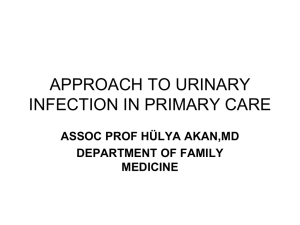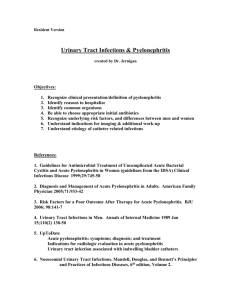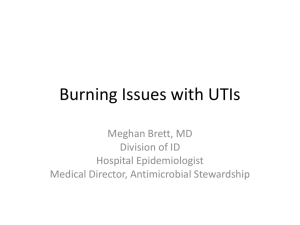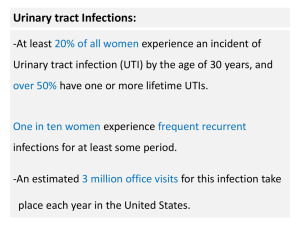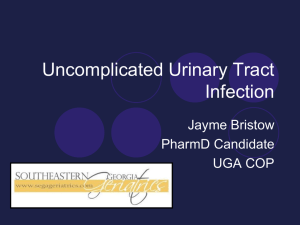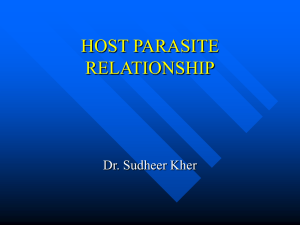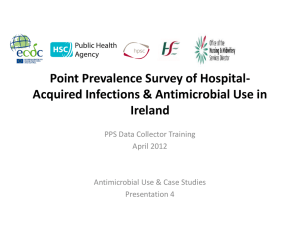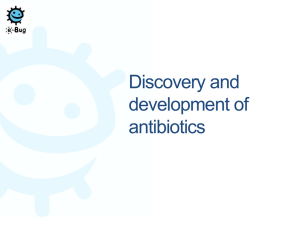Principles of antimicrobial treatment
advertisement
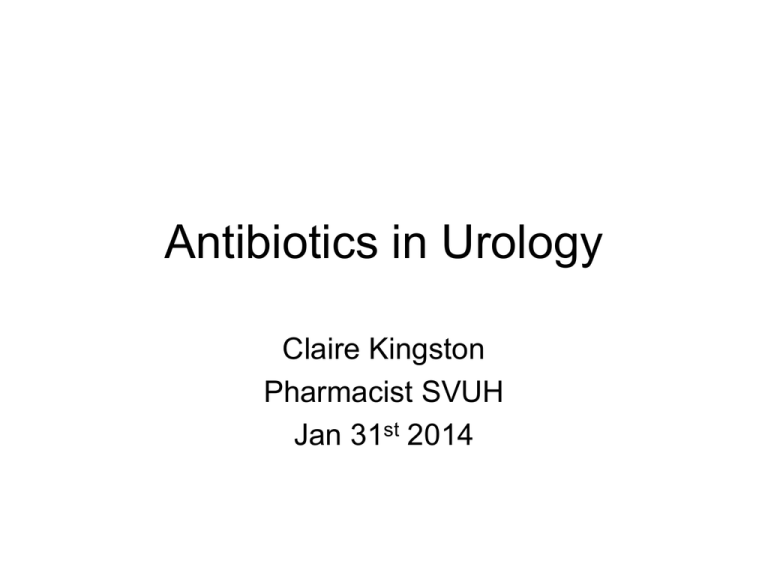
Antibiotics in Urology Claire Kingston Pharmacist SVUH Jan 31st 2014 Introduction – Urinary tract Infection (UTI) • 2nd most common clinical indication for empirical antimicrobial treatment • Inappropriate and unnecessary use of antibiotics associated with problems such as Clostridium difficile infection (CDI), MRSA, VRE • Evidence-based antibiotic guidelines are key to improving prescribing, reducing resistance & optimising patient outcomes • Antimicrobial Prescribing in Primary Care (2011) now available on http://www.antibioticprescibing.ie/ Principles of antimicrobial treatment – empirical prescribing • Treat patient not result • Ensure provisional clinical diagnosis documented & specimens taken before start of therapy. • Broad spectrum empirical therapy for severe infections, then de-escalate once causative organism identified. • Check C/I, allergies, interactions, adverse effects. • IV route initially if severe infection, or unable to tolerate oral drugs. Review Rx after 48 hours . Principles of antimicrobial treatment • Local policies often limit drugs use based on economics & local resistance • Sample should be taken for C+S testing before starting therapy - will identify the causative pathogen & its susceptibility pattern. • Dose may vary depending on age, weight, hepatic & renal function, severity of infection • Route may depend on severity on infection • Duration depends on infection & response DAY 1 START SMART… THEN… a) Do not start antibiotics if no clinical evidence of DAY 2 …. ONWARDS bacterial infection b) Obtain cultures first c) EMPIRIC TREATMENT BASED ON ANTIMICROBIAL GUIDELINES or BASED ON MICROBIOLOGY ADVICE REVIEW TREATMENT FOCUS 1. STOP ANTIBIOTICS 2. CONTINUE ANTIBIOTICS/ PLAN TREATMENT/ COURSE 3. CHANGE ANTIBIOTICS/ PLAN/TREATMENT COURSE 4. SWITCH TO PO IF APPROPRIATE 5. CONSIDER OPAT IF APPROPRIATE ALWAYS DOCUMENT INDICATION FOR THE ANTIMICROBIAL AND TREATMENT PLAN IN THE MEDICAL NOTES Adapated from ARHAI Antimicrobial Stewardship Guidance Nov 2011 Classification of antibiotics:β-lactams • Penicillins – – – – Benzylpenicillin, phenoxymethylphenicillin Penicillinase-resistant, e.g. flucloxacillin Broad-spectrum, e.g. amoxycillin, co-amoxiclav Antipseudomonal, e.g.Tazocin, Timentin • Cephalosporins e.g. cephalexin, ceftriaxone • Carbapenems – e.g. ertapenem, meropenem – Meropenem used for complicated UTIs & severe hospital infxns. – Ertapenem – seizure potential. Resistance • Other beta-lactams – e.g. aztreonam Penicillins – Hypersenstivity • Allergies in 1-10% patients, anaphylaxis in 0.05% • Greater risk if history of atopic allergy • If history of anaphylaxis, urticaria or rash immediately after penicillin – do not give penicillins or cephalosporins • If history of minor rash (non-pruritic, small area) more than 72 hours after drug – may not be allergic • 0.5-0.65% penicillin-sensitive patients will also be allergic to cephalosporins • Aztreonam less likely to cause hypersensitivity. Classification of antibiotics (contd) • • • • Aminoglycosides – e.g.gentamicin Glycopepdidases – e.g. teicoplanin, vancomycin Macrolides – e.g. clarithromycin Quinolones – e.g. ciprofloxacin - Ensure adequate fluid intake (risk of crystalliuria) - May impair performance of skilled tasks - Caution if history of seizures - Photosensitivity reactions - Prolongs QT interval - Give > 1 hour before ( or > 4 hours after) Mg, iron, dairy products Aminoglycoside once-daily dosing e.g. gentamicin • Total dose should be specified on Rx. Use accurate weight. • If patient is obese use dosing weight calculator to calculate dose (www.UptoDate.com) • Usual dose 5mg/kg/day (normal renal function) or 2mg/kg/day if serum creatinine >120 umol/L or GFR <80ml/min • Take level before 2nd or 3rd dose and 18-24 hours after last dose (= trough). • Give (ideally) at 6pm to facilitate morning assay • Check levels 2-3 times weekly in patients < 50 years and every 2nd day if > 50 years. If renal function abnormal, do daily levels. • Target level < 1mg/l Classification of antibiotics (contd) • Trimethoprim - synergistic with sulfamethoxazole (cotrimoxazole) - serum creatinine may rise due to competition for renal excretion - may cause hyperkalaemia in severe renal impairment - Stevens Johnson’s syndrome & blood dyscrasias rare • Tetracyclines – e.g. doxycycline, (Tigecycline) • Nitrofurantoin - can cause peripheral neuropathy - avoid in GFR < 20mls/min as inadequate urine conc & toxicity (blood dyscrasias, neuropathy) - pulmonary reactions (e.g.pulmonary fibrosis) reported • Others – e.g. daptomycin, linezolid, sodium fusidate, colistin, metronidazole, clindamycin, rifaximin Extended Spectrum B-lactamases (ESBLs) • Enzymes produced by some bacteria that provide resistance to extended spectrum (3rd generation) cephalosporins, & monobactams (aztreonam). Don’t affect carbapenems. • Beta-lactamase provides antibiotic resistance by breaking the antibiotic’s structure. • Gram-negative enteric bacteria, in particular K pneumoniae and E coli, are involved • ESBLs are multi-resistant but remain sensitive to nitrofurantoin Classification of urinary & male genital tract infections • • • • • • Uncomplicated lower UTI (cystitis) Uncomplicated pyelonephritis Complicated UTI +/- pyelonephritis Urosepsis Urethritis Prostatits, epididymitis, orchitis Significant bacteriuria in adults • 1. ≥ 103 uropathogens/mL of midstream urine in acute uncomplicated cystitis in female. • 2. ≥ 104 uropathogens/mL of midstream urine in acute uncomplicated pyelonephritis in female. • 3. ≥ 105 uropathogens/mL in midstream urine of women or 104 uropathogens/mL of midstream urine in men (or in straight catheter urine in women) with complicated UTI. • 4. In a suprapubic bladder puncture specimen, any count of bacteria is relevant. • 5. Asymptomatic bacteriuria = two positive urine cultures taken ≥ 24 hours apart containing ≥ 105 uropathogens/ml of the same bacterial strain. Acute, uncomplicated UTIs • Includes acute cystitis & acute pyelonephritis • Mostly in women without structural & functional abnormalities within the urinary tract, kidney diseases or co-morbidity • E.coli responsible for 70-95% cases, S. saprophyticus in 5-10% cases Treatment for Acute Uncomplicated Cystitis 1. 2. 3. 4. 5. Nitrofurantoin 50-100mg QDS for 3 - 7 days – low resistance & S/E, high efficacy. Activity effected by urinary pH - avoid alkalinising agents if on. Trimethoprim 200mg BD for 3 days or Trimethoprimsulfamethoxazole 160/800mg BD for 3 days (if resistance rate < 20%). -lactams (e.g. co-amoxiclav, cephalexin), – inferior efficacy & increased adverse effects. Only use if others can’t be used – used based on local resistance rates. Amoxicillin/ampicillin should not be used (resistance/poor efficacy). Fluoroquinolones (e.g. ciprofloxacin) – efficacious but high S/E – not recommended routinely. Reserve for resistant infections with limited option & confirmed by C + S results. Fosfomycin 3g stat – minimal resistance & S/E but may be less efficacious –microbiology advice. Prophylaxis with probiotics / cranberry • Probiotics: – Oral probiotics – may restore vaginal lactobacilli, compete with urogenital pathogens & prevent vaginosis – Intravaginal probiotics once/twice weekly – L. rhamnosus GR-1 & L. reuteri RC-14 • Cranberry: – Some evidence (min 36mg proanthocyanidin A) may reduce rate of lower UTIs is women, but small number of weak clinical studies. Can increase INR. UTIs in men • Acute, uncomplicated UTIs in young men: need at least 7 days treatment • Most men with febrile UTI have concomitant prostate infection ( PSA & prostate volume). If so 2 weeks treatment ( up to 3 weeks) is recommended preferably with a fluoroquinolone. Complicated UTIs due to urological disorders • Infection associated with a condition such as a structural or functional abnormality of genitourinary tract, or underlying disease that interferes with host defences • Broad range of bacteria responsible – larger spectrum & resistance than uncomplicated UTIs • Enterobacteriacae predominate, E. coli most common pathogen. Pseudomonas, serratia & + cocci (e.g. staphylococci & enterococci) also involved • Proteus & pseudomonas particularly common with urinary stones • Need 7-14 days treatment Treatment for Acute Pyelonephritis • • • If no healthcare contact or antibiotic therapy in past 6 months: Ciprofloxacin 500mg BD for 7 days (+/- 400mg IV stat) for mild-moderate infection if resistance < 10%. Can be +/- gentamicin. Trimethoprim 200mg BD for 14 days or Trimethoprim-sulfamethoxazole 160/800mg BD if sensitivities allow. Oral -lactams less effective. Co-amoxiclav 500/125mg TDS for 14 days may be option. Treatment for Acute Pyelonephritis If healthcare contact or antibiotic therapy in past 6 months: • Piperacillin-tazobactam 4.5g 8 hourly IV (Aztreonam 2g 8 hourly IV if penicillin rash or anaphylaxis) PLUS • Gentamicin once daily IV • Usually 14 day treatment Catheter associated UTIs (CAUTIs) • Most are derived from the patient’s own colonic flora • Duration of catheterisation is most important risk factor (> 30 days) • While catheter in place, treatment of asymptomatic catheter-asociated bacteriuria is not recommended. • Routine urine cultures in asymptomatic catheterised patients not recommended • Urine (& in septic patients, also blood cultures) should be taken before antimicrobial therapy is started to guide therapy • 7 days course of antibiotic reasonable. Change or removal of urinary catheter • Ciprofloxacin 500mg PO 1 hour prior to removal OR ciprofloxacin 400mg IV immediately prior to removal OR gentamicin 2mg/kg IV immediately prior to removal Transrectal prostate biopsy • Ciprofloxacin 750mg PO AND amikacin 500mg IM one hour pre-procedure. • Give second dose of Ciprofloxacin 750mg 12 hours post-procedure • Check recent urine culture results and modify as necessary References • BNF, 66th edition (2013) • European Society of Urology Guidelines (2013) • SIGN 88 – Management of suspected bacterial urinary tract infection in adults (2012) QUIZ!

